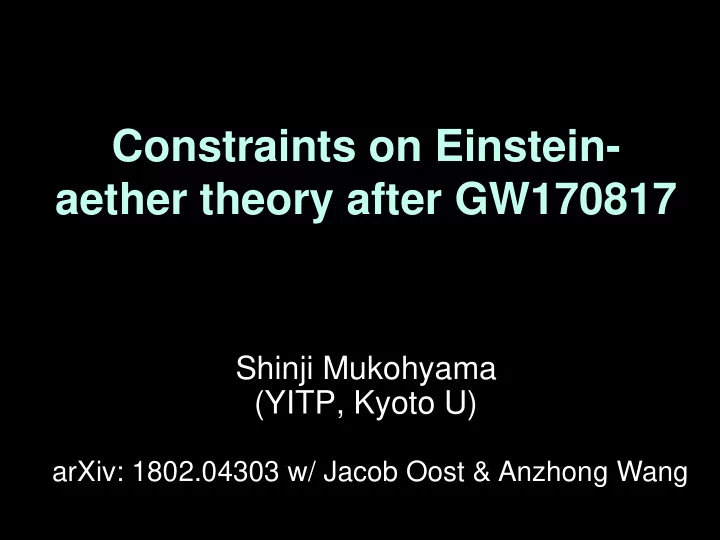

Constraints on Einstein- aether theory after GW170817 Shinji Mukohyama (YITP, Kyoto U) arXiv: 1802.04303 w/ Jacob Oost & Anzhong Wang
Im Implication of f GW170817 on on gravity theories @ la late tim ime 2 – c g • |c gw 2 | < 10 -15 • Horndeski theoy (scalar-tensor theory with 2 nd -order eom): Among 4 free functions, G 4 ( f ,X) & G 5 ( f ,X) are strongly constrained. Still G 2 ( f ,X) & G 3 ( f ,X) are free. • Generalized Proca theory (vector-tensor theory): Among 6 (or more) free functions, G 4 (X) & G 5 (X) are strongly constrained. Still G 2 (X,F,Y,U), G 3 (X), G 6 (X), g 5 (X) are free. • Horava-Lifshitz theory (renormalizable quantum gravity): The coefficient of R (3) is strongly constrained 2 = c g IR fixed point with c gw 2 ? How to speed up the RG flow? • Ghost condensation (simplest Higgs phase of gravity): No additional constraint • Massive gravity (simplest modification of GR): Upper bound on graviton mass ≈ 10 -22 eV Much weaker than the requirement from acceleration c.f. “All” gravity theories (including general relativity): The cosmological constant is strongly constrained ≈ 10 -120 .
Einstein-aether theory • LV gravity: GR + timelike unit vector u m Useful for test of GR • Low-E limit of non-projectable HL gravity predictions of a quantum gravity theory • 4 parameters (c 1 , c 2 , c 3 , c 4 )
Constraints • Stability • Gravi-Cerenkov • GW170817 • BBN • PPN • Pulsars
Some formulae • Stability & Gravi-Cerenkov & GW170817 • BBN • PPN • Pulsars
Constraints on (c 1 , c 2 , c 3 , c 4 ) • Strongest constraint GW170817 • (c 1 , c 14 )-plane (c 2 , c 14 )-plane • (c 2 , c 14 )-plane • Sensitivity not known in those range
Im Implication of f GW170817 on on gravity theories @ la late tim ime 2 – c g • |c gw 2 | < 10 -15 • Horndeski theoy (scalar-tensor theory with 2 nd -order eom): Among 4 free functions, G 4 ( f ,X) & G 5 ( f ,X) are strongly constrained. Still G 2 ( f ,X) & G 3 ( f ,X) are free. • Generalized Proca theory (vector-tensor theory): Among 6 (or more) free functions, G 4 (X) & G 5 (X) are strongly constrained. Still G 2 (X,F,Y,U), G 3 (X), G 6 (X), g 5 (X) are free. • Horava-Lifshitz theory (renormalizable quantum gravity): The coefficient of R (3) is strongly constrained 2 = c g IR fixed point with c gw 2 ? How to speed up the RG flow? • Ghost condensation (simplest Higgs phase of gravity): No additional constraint • Massive gravity (simplest modification of GR): Upper bound on graviton mass ≈ 10 -22 eV Much weaker than the requirement from acceleration c.f. “All” gravity theories (including general relativity): The cosmological constant is strongly constrained ≈ 10 -120 .
Recommend
More recommend